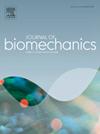异质组织失效的多尺度离散纤维模型:重塑脑动脉瘤的应用。
IF 2.4
3区 医学
Q3 BIOPHYSICS
引用次数: 0
摘要
损伤累积失效模型被广泛用于研究机械负载引起的组织特性变化。然而,损伤累积模型纯粹是一种现象学模型。使用这类模型的基本理由通常是细胞外纤维和/或细胞发生了损伤,从而改变了系统的基本机械行为。在这项研究中,我们试图将损伤累积模型与微观结构模型结合起来,以预测生物材料力学行为的改变,这种改变源于与组织非均匀重塑相关的结构异质性。此外,我们还试图将这种多尺度模型扩展到评估灾难性失效事件(如脑动脉瘤破裂)。首先,我们证明了由线性弹性蛋白和肌动蛋白以及非线性胶原纤维组成的模型可以复制单轴拉伸脑动脉瘤的失效前和失效组织尺度力学。接下来,我们将研究机械异质性(如在脑动脉瘤中观察到的异质性)如何影响纤维和组织的失效。值得注意的是,我们发现失效发生在高材料刚度和低材料刚度区域之间的界面,这表明空间机械异质性会影响动脉瘤的失效行为。该模型系统朝着将生长和重塑过程中的结构变化与失效特性联系起来迈出了一步。本文章由计算机程序翻译,如有差异,请以英文原文为准。
A multiscale discrete fiber model of failure in heterogeneous tissues: Applications to remodeled cerebral aneurysms
Damage-accumulation failure models are broadly used to examine tissue property changes caused by mechanical loading. However, damage accumulation models are purely phenomenological. The underlying justification in using this type of model is often that damage occurs to the extracellular fibers and/or cells which changes the fundamental mechanical behavior of the system. In this work, we seek to align damage accumulation models with microstructural models to predict alterations in the mechanical behavior of biological materials that arise from structural heterogeneity associated with nonuniform remodeling of tissues. Further, we seek to extend this multiscale model toward assessing catastrophic failure events such as cerebral aneurysm rupture. First, we demonstrate that a model made up of linear elastin and actin and nonlinear collagen fibers can replicate bot the pre-failure and failure tissue-scale mechanics of uniaxially-stretched cerebral aneurysms. Next, we investigate how mechanical heterogeneities, like those observed in cerebral aneurysms, influence fiber and tissue failure. Notably, we find that failure occurs and the interface between regions of high and low material stiffness, suggesting that spatial mechanical heterogeneity influences aneurysm failure behavior. This model system is a step toward linking structural changes in growth and remodeling to failure properties.
求助全文
通过发布文献求助,成功后即可免费获取论文全文。
去求助
来源期刊

Journal of biomechanics
生物-工程:生物医学
CiteScore
5.10
自引率
4.20%
发文量
345
审稿时长
1 months
期刊介绍:
The Journal of Biomechanics publishes reports of original and substantial findings using the principles of mechanics to explore biological problems. Analytical, as well as experimental papers may be submitted, and the journal accepts original articles, surveys and perspective articles (usually by Editorial invitation only), book reviews and letters to the Editor. The criteria for acceptance of manuscripts include excellence, novelty, significance, clarity, conciseness and interest to the readership.
Papers published in the journal may cover a wide range of topics in biomechanics, including, but not limited to:
-Fundamental Topics - Biomechanics of the musculoskeletal, cardiovascular, and respiratory systems, mechanics of hard and soft tissues, biofluid mechanics, mechanics of prostheses and implant-tissue interfaces, mechanics of cells.
-Cardiovascular and Respiratory Biomechanics - Mechanics of blood-flow, air-flow, mechanics of the soft tissues, flow-tissue or flow-prosthesis interactions.
-Cell Biomechanics - Biomechanic analyses of cells, membranes and sub-cellular structures; the relationship of the mechanical environment to cell and tissue response.
-Dental Biomechanics - Design and analysis of dental tissues and prostheses, mechanics of chewing.
-Functional Tissue Engineering - The role of biomechanical factors in engineered tissue replacements and regenerative medicine.
-Injury Biomechanics - Mechanics of impact and trauma, dynamics of man-machine interaction.
-Molecular Biomechanics - Mechanical analyses of biomolecules.
-Orthopedic Biomechanics - Mechanics of fracture and fracture fixation, mechanics of implants and implant fixation, mechanics of bones and joints, wear of natural and artificial joints.
-Rehabilitation Biomechanics - Analyses of gait, mechanics of prosthetics and orthotics.
-Sports Biomechanics - Mechanical analyses of sports performance.
 求助内容:
求助内容: 应助结果提醒方式:
应助结果提醒方式:


